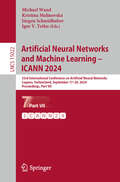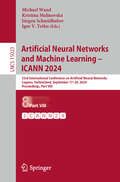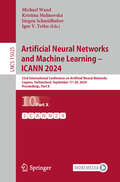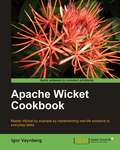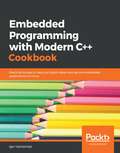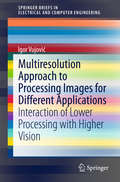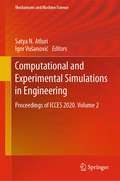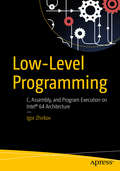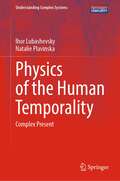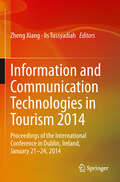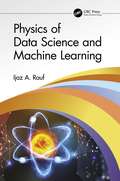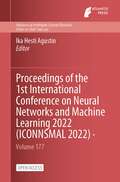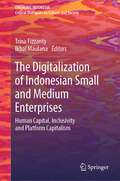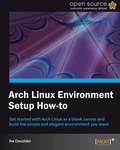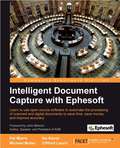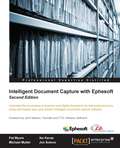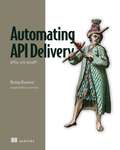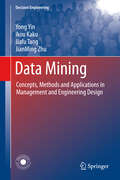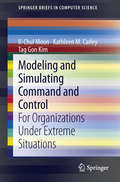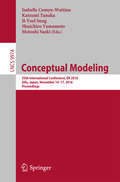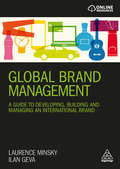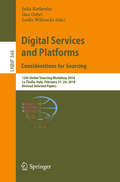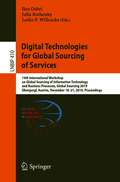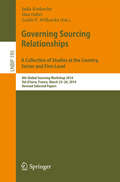- Table View
- List View
Artificial Neural Networks and Machine Learning – ICANN 2024: 33rd International Conference on Artificial Neural Networks, Lugano, Switzerland, September 17–20, 2024, Proceedings, Part VII (Lecture Notes in Computer Science #15022)
by Igor V. Tetko Jürgen Schmidhuber Michael Wand Kristína MalinovskáThe ten-volume set LNCS 15016-15025 constitutes the refereed proceedings of the 33rd International Conference on Artificial Neural Networks and Machine Learning, ICANN 2024, held in Lugano, Switzerland, during September 17–20, 2024. The 294 full papers and 16 short papers included in these proceedings were carefully reviewed and selected from 764 submissions. The papers cover the following topics: Part I - theory of neural networks and machine learning; novel methods in machine learning; novel neural architectures; neural architecture search; self-organization; neural processes; novel architectures for computer vision; and fairness in machine learning. Part II - computer vision: classification; computer vision: object detection; computer vision: security and adversarial attacks; computer vision: image enhancement; and computer vision: 3D methods. Part III - computer vision: anomaly detection; computer vision: segmentation; computer vision: pose estimation and tracking; computer vision: video processing; computer vision: generative methods; and topics in computer vision. Part IV - brain-inspired computing; cognitive and computational neuroscience; explainable artificial intelligence; robotics; and reinforcement learning. Part V - graph neural networks; and large language models. Part VI - multimodality; federated learning; and time series processing. Part VII - speech processing; natural language processing; and language modeling. Part VIII - biosignal processing in medicine and physiology; and medical image processing. Part IX - human-computer interfaces; recommender systems; environment and climate; city planning; machine learning in engineering and industry; applications in finance; artificial intelligence in education; social network analysis; artificial intelligence and music; and software security. Part X - workshop: AI in drug discovery; workshop: reservoir computing; special session: accuracy, stability, and robustness in deep neural networks; special session: neurorobotics; and special session: spiking neural networks.
Artificial Neural Networks and Machine Learning – ICANN 2024: 33rd International Conference on Artificial Neural Networks, Lugano, Switzerland, September 17–20, 2024, Proceedings, Part VIII (Lecture Notes in Computer Science #15023)
by Igor V. Tetko Jürgen Schmidhuber Michael Wand Kristína MalinovskáThe ten-volume set LNCS 15016-15025 constitutes the refereed proceedings of the 33rd International Conference on Artificial Neural Networks and Machine Learning, ICANN 2024, held in Lugano, Switzerland, during September 17–20, 2024. The 294 full papers and 16 short papers included in these proceedings were carefully reviewed and selected from 764 submissions. The papers cover the following topics: Part I - theory of neural networks and machine learning; novel methods in machine learning; novel neural architectures; neural architecture search; self-organization; neural processes; novel architectures for computer vision; and fairness in machine learning. Part II - computer vision: classification; computer vision: object detection; computer vision: security and adversarial attacks; computer vision: image enhancement; and computer vision: 3D methods. Part III - computer vision: anomaly detection; computer vision: segmentation; computer vision: pose estimation and tracking; computer vision: video processing; computer vision: generative methods; and topics in computer vision. Part IV - brain-inspired computing; cognitive and computational neuroscience; explainable artificial intelligence; robotics; and reinforcement learning. Part V - graph neural networks; and large language models. Part VI - multimodality; federated learning; and time series processing. Part VII - speech processing; natural language processing; and language modeling. Part VIII - biosignal processing in medicine and physiology; and medical image processing. Part IX - human-computer interfaces; recommender systems; environment and climate; city planning; machine learning in engineering and industry; applications in finance; artificial intelligence in education; social network analysis; artificial intelligence and music; and software security. Part X - workshop: AI in drug discovery; workshop: reservoir computing; special session: accuracy, stability, and robustness in deep neural networks; special session: neurorobotics; and special session: spiking neural networks.
Artificial Neural Networks and Machine Learning – ICANN 2024: 33rd International Conference on Artificial Neural Networks, Lugano, Switzerland, September 17–20, 2024, Proceedings, Part X (Lecture Notes in Computer Science #15025)
by Igor V. Tetko Jürgen Schmidhuber Michael Wand Kristína MalinovskáThe ten-volume set LNCS 15016-15025 constitutes the refereed proceedings of the 33rd International Conference on Artificial Neural Networks and Machine Learning, ICANN 2024, held in Lugano, Switzerland, during September 17–20, 2024. The 294 full papers and 16 short papers included in these proceedings were carefully reviewed and selected from 764 submissions. The papers cover the following topics: Part I - theory of neural networks and machine learning; novel methods in machine learning; novel neural architectures; neural architecture search; self-organization; neural processes; novel architectures for computer vision; and fairness in machine learning. Part II - computer vision: classification; computer vision: object detection; computer vision: security and adversarial attacks; computer vision: image enhancement; and computer vision: 3D methods. Part III - computer vision: anomaly detection; computer vision: segmentation; computer vision: pose estimation and tracking; computer vision: video processing; computer vision: generative methods; and topics in computer vision. Part IV - brain-inspired computing; cognitive and computational neuroscience; explainable artificial intelligence; robotics; and reinforcement learning. Part V - graph neural networks; and large language models. Part VI - multimodality; federated learning; and time series processing. Part VII - speech processing; natural language processing; and language modeling. Part VIII - biosignal processing in medicine and physiology; and medical image processing. Part IX - human-computer interfaces; recommender systems; environment and climate; city planning; machine learning in engineering and industry; applications in finance; artificial intelligence in education; social network analysis; artificial intelligence and music; and software security. Part X - workshop: AI in drug discovery; workshop: reservoir computing; special session: accuracy, stability, and robustness in deep neural networks; special session: neurorobotics; and special session: spiking neural networks.
Apache Wicket Cookbook
by Igor VaynbergThis is a hands-on practical guide to a large variety of topics and use cases. This book tries to use real-world examples when possible, but is not afraid to come up with a contrived pretext if it makes explaining the problem simpler. Unlike a lot of other books, this one does not try to maintain a continuous theme from chapter to chapter, such as demonstrating solutions on the same fictional application; doing so would be almost impossible given the wide variety of recipes presented here. Instead, this book concentrates on focused problems users are likely to encounter and shows clear solutions in a step-by-step manner. This book tries to teach by example and is not afraid to show a lot of code because, after all, it is for coders. This book is for current users of the Apache Wicket framework; it is not an introduction to Wicket that will bore you with tons of theory. You are expected to have built or maintained a simple Wicket application in the past and to be looking to learn new and better ways of using Wicket. If you are ready to take your Wicket skills to the next level this book is for you.
Embedded Programming with Modern C++ Cookbook: Practical recipes to help you build robust and secure embedded applications on Linux
by Igor ViarheichykExplore various constraints and challenges that embedded developers encounter in their daily tasks and learn how to build effective programs using the latest standards of C++ Key Features Get hands-on experience in developing a sample application for an embedded Linux-based system Explore advanced topics such as concurrency, real-time operating system (RTOS), and C++ utilities Learn how to test and debug your embedded applications using logs and profiling tools Book Description Developing applications for embedded systems may seem like a daunting task as developers face challenges related to limited memory, high power consumption, and maintaining real-time responses. This book is a collection of practical examples to explain how to develop applications for embedded boards and overcome the challenges that you may encounter while developing. The book will start with an introduction to embedded systems and how to set up the development environment. By teaching you to build your first embedded application, the book will help you progress from the basics to more complex concepts, such as debugging, logging, and profiling. Moving ahead, you will learn how to use specialized memory and custom allocators. From here, you will delve into recipes that will teach you how to work with the C++ memory model, atomic variables, and synchronization. The book will then take you through recipes on inter-process communication, data serialization, and timers. Finally, you will cover topics such as error handling and guidelines for real-time systems and safety-critical systems. By the end of this book, you will have become proficient in building robust and secure embedded applications with C++. What you will learn Get to grips with the fundamentals of an embedded system Understand how to optimize code for the targeted hardware platforms Explore cross-compilation, build types, and remote debugging Discover the importance of logging for debugging and root cause analysis of failures Uncover concepts such as interrupt service routine, memory model, and ring buffer Recognize the need for custom memory management in embedded systems Delve into static code analyzers and tools to improve code quality Who this book is for This book is for developers, electronic hardware professionals, and software and system-on-chip engineers who want to build effective embedded programs in C++. Familiarity with the C++ programming language is expected, but no previous knowledge of embedded systems is required.
Multiresolution Approach to Processing Images for Different Applications
by Igor VujovićThis book presents theoretical and practical aspects of the interaction between low and high level image processing. Multiresolution analysis owes its popularity mostly to wavelets and is widely used in a variety of applications. Low level image processing is important for the performance of many high level applications. The book includes examples from different research fields, i. e. video surveillance; biomedical applications (EMG and X-ray); improved communication, namely teleoperation, telemedicine, animation, augmented/virtual reality and robot vision; monitoring of the condition of ship systems and image quality control.
Computational and Experimental Simulations in Engineering: Proceedings of ICCES 2020. Volume 2 (Mechanisms and Machine Science #98)
by Satya N. Atluri Igor VušanovićThis book gathers the latest advances, innovations, and applications in the field of computational engineering, as presented by leading international researchers and engineers at the 26th International Conference on Computational & Experimental Engineering and Sciences (ICCES), held in Phuket, Thailand on January 6-10, 2021. ICCES covers all aspects of applied sciences and engineering: theoretical, analytical, computational, and experimental studies and solutions of problems in the physical, chemical, biological, mechanical, electrical, and mathematical sciences. As such, the book discusses highly diverse topics, including composites; bioengineering & biomechanics; geotechnical engineering; offshore & arctic engineering; multi-scale & multi-physics fluid engineering; structural integrity & longevity; materials design & simulation; and computer modeling methods in engineering. The contributions, which were selected by means of a rigorous international peer-review process, highlight numerous exciting ideas that will spur novel research directions and foster multidisciplinary collaborations.
Low-Level Programming
by Igor ZhirkovLearn Intel 64 assembly language and architecture, become proficient in C, and understand how the programs are compiled and executed down to machine instructions, enabling you to write robust, high-performance code. Low-Level Programming explains Intel 64 architecture as the result of von Neumann architecture evolution. The book teaches the latest version of the C language (C11) and assembly language from scratch. It covers the entire path from source code to program execution, including generation of ELF object files, and static and dynamic linking. Code examples and exercises are included along with the best code practices. Optimization capabilities and limits of modern compilers are examined, enabling you to balance between program readability and performance. The use of various performance-gain techniques is demonstrated, such as SSE instructions and pre-fetching. Relevant Computer Science topics such as models of computation and formal grammars are addressed, and their practical value explained. What You'll Learn Low-Level Programming teaches programmers to: Freely write in assembly language Understand the programming model of Intel 64 Write maintainable and robust code in C11 Follow the compilation process and decipher assembly listings Debug errors in compiled assembly code Use appropriate models of computation to greatly reduce program complexity Write performance-critical code Comprehend the impact of a weak memory model in multi-threaded applications Who This Book Is For Intermediate to advanced programmers and programming students
Physics of the Human Temporality: Complex Present (Understanding Complex Systems)
by Ihor Lubashevsky Natalie PlavinskaThis book presents a novel account of the human temporal dimension called the “human temporality” and develops a special mathematical formalism for describing such an object as the human mind. One of the characteristic features of the human mind is its temporal extent. For objects of physical reality, only the present exists, which may be conceived as a point-like moment in time. In the human temporality, the past retained in the memory, the imaginary future, and the present coexist and are closely intertwined and impact one another.This book focuses on one of the fragments of the human temporality called the complex present. A detailed analysis of the classical and modern concepts has enabled the authors to put forward the idea of the multi-component structure of the present. For the concept of the complex present, the authors proposed a novel account that involves a qualitative description and a special mathematical formalism. This formalism takes into account human goal-oriented behavior and uncertainty in human perception.The present book can be interesting for theoreticians, physicists dealing with modeling systems where the human factor plays a crucial role, philosophers who are interested in applying philosophical concepts to constructing mathematical models, and psychologists whose research is related to modeling mental processes.
Information and Communication Technologies in Tourism 2014
by Zheng Xiang Iis TussyadiahThe papers presented in this volume advance the state-of-the-art research on social media and Web 2. 0, electronic tourism marketing, website development and evaluation, search engine marketing and optimization, IT adoption and diffusion, virtual travel communities, mobile technologies, management information systems in tourism, eLearning, recommender systems for tourism businesses and destinations and electronic distribution for hospitality and travel products. This book covers the most significant topics contributed by prominent scholars from around the world and is suitable for both academics and practitioners who are interested in the latest developments in e-Tourism.
Physics of Data Science and Machine Learning
by Ijaz A. RaufPhysics of Data Science and Machine Learning links fundamental concepts of physics to data science, machine learning and artificial intelligence for physicists looking to integrate these techniques into their work. This book is written explicitly for physicists, marrying quantum and statistical mechanics with modern data mining, data science, and machine learning. It also explains how to integrate these techniques into the design of experiments, whilst exploring neural networks and machine learning building on fundamental concepts of statistical and quantum mechanics. This book is a self-learning tool for physicists looking to learn how to utilize data science and machine learning in their research. It will also be of interest to computer scientists and applied mathematicians, alongside graduate students looking to understand the basic concepts and foundations of data science, machine learning, and artificial intelligence. Although specifically written for physicists, it will also help provide non-physicists with an opportunity to understand the fundamental concepts from a physics perspective to aid the development of new and innovative machine learning and artificial intelligence tools. Key features: Introduces the design of experiments and digital twin concepts in simple lay terms for physicists to understand, adopt, and adapt. Free from endless derivations, instead equations are presented and explained strategically and explain why it is imperative to use them and how they will help in the task at hand. Illustrations and simple explanations help readers visualize and absorb the difficult to understand concepts. Ijaz A. Rauf is Adjunct Professor at the School of Graduate Studies, York University, Toronto, Canada. He is also an Associate Researcher at Ryerson University, Toronto, Canada and President of the Eminent-Tech Corporation, Bradford, ON, Canada.
Proceedings of the 1st International Conference on Neural Networks and Machine Learning 2022 (Advances in Intelligent Systems Research #177)
by Ika Hesti AgustinThis is an open access book. The 1st ICONNSMAL 2022 was held at CGANT Research Group the University of Jember, Jember, East-Java, Indonesia.
The Digitalization of Indonesian Small and Medium Enterprises: Human Capital, Inclusivity and Platform Capitalism (Engaging Indonesia)
by Trina Fizzanty Ikbal MaulanaThis book examines the digitalization of Small and Medium Enterprises (SMEs) in Indonesia and its challenges in the context of an emerging economy and the Covid-19 crisis. During the Covid-19 pandemic, business digitalization became a must for a business to avoid collapse and people saw that digital transformation is a panacea for SMEs to help them survive and revive from the crises. Governments and other stakeholders in many countries including Indonesia have launched policies and programs to support SMEs. Transforming SMEs' conventional businesses into digitalized versions, however, is a complex issue influenced by various factors. These factors encompass both internal changes within the organization and external dynamics in the ecosystem in which they operate. This book, therefore, is a new approach towards understanding the digitalization of SMEs in Indonesia and includes contributions from scholars with different, multi-disciplinary perspectives and demonstrates that digital transformation of SMEs is not all about technology adoption but also involves other aspects such as social, economic, and public governance factors. It discusses opportunities and challenges of digital transformation of SMEs in Indonesia, such as digital talent, financial inclusion, platform capitalism, automation, government’s role, governance, open competition, and inclusive digital economy. The book is of interest to researchers and students of social economics, SMEs and entrepreneurship, human capital research, and economy and governance.
Arch Linux Environment Setup How-To
by Ike DevolderEach task expresses a specific task for setting up an Arch Linux environment. The recipe as a solution is a carefully organized set of instructions to perform the task as efficiently as possible and a discussion on how to apply the solution in different situations. "Arch Linux Environment Set-up" How to is for people wanting to dig deep into a Linux system. By the end of the book you will have basic knowledge how a Linux system is built up, how it boots and a general idea of how it is working. The book also assumes you already know what partitioning is and if you need dual booting you already have some experience with that. For people only trying out Arch Linux the author would suggest following this guide inside a virtual machine.
Intelligent Document Capture with Ephesoft
by Michael Muller Ike KavasWritten in easy to follow manner, this book is a complete guide to Document capture with Ephesoft,This book is intended for information technology professionals interested in installing and configuring Ephesoft for their organization, but it is a valuable resource for anyone interested in learning about document capture in general.
Intelligent Document Capture with Ephesoft - Second Edition
by Ike Kavas Pat MyersAutomate the processing of scanned and digital documents by improving accuracy using web-based open and modern intelligent document capture software About This Book * Learn how to implement the benefits of intelligent document capture using Ephesoft Enterprise 4 * Leverage the power of the open platform to run it as a classic intake capture system to make your current portals or applications more intelligent * A practical guide providing examples for optimizing document capture for your business Who This Book Is For This book is intended for information technology professionals interested in installing and configuring Ephesoft Enterprise for their organization, but it is a valuable resource for anyone interested in learning about intelligent document capture. What You Will Learn * Discover the benefits of using intelligent document capture in your work place * Learn to capture, classify, and separate any type of document * Extract important information from your documents * Transfer the documents and data into your content management system * Customize Ephesoft to meet your unique business requirements * Understand the integration techniques using the Ephesoft web services API * Convert your paper archive to electronic records efficiently * Automate business processes that depend on documents in paper, fax, or email attachment format * Implement distributed capture for mailroom automation In Detail Every organization, public or private, processes documents in various formats, especially paper and fax formats. Processing documents manually is an expensive and time-consuming endeavor. Ephesoft Enterprise is a modern document capture solution that allows an organization to automate the business process. It uses powerful technology to classify and capture the vital information from the document's content. This helps to minimize the time your company spends on reviewing and processing any physical and electronic documents. This book teaches you about document capture in general and implementation of document capture using Ephesoft. Start by learning about document capture and how Ephesoft revolutionized the industry. Progress to a tour of key features, including operator and administrator interfaces and then learn to configure Ephesoft to process your business's specific document types and extract content from those documents. You will also get to know the advanced customization techniques that make Ephesoft accommodate your unique business needs. Finally, the book concludes by teaching you how to embed the classification and extraction functionality using Ephesoft's web services. By the end, you will learn to optimize the processing of your documents, saving your company time and money. Style and approach This is a step-by-step guide on how to configure and use Ephesoft using an accounts payable use case. The book will start with basic techniques and progress to more advanced features that allow you to leverage the power for a modern powerful capture system.
Automating API Delivery: APIOps with OpenAPI
by Ikenna NwaiwuImprove speed, quality, AND cost by automating your API delivery process!Automating API Delivery shows you how to strike the perfect balance between speed and usability by applying DevOps automation principles to your API design and delivery process. It lays out a clear path to making both the organizational and technical changes you need to deliver high-quality APIs both rapidly and reliably. In Automating API Delivery you&’ll learn how to: Enforce API design standards with linting Automate breaking-change checks to control design creep Ensure accuracy of API reference documents Centralize API definition consistency checks Automate API configuration deployment Conduct effective API design reviews Author Ikenna Nwaiwu provides comprehensive guidance on implementing APIOps in your organization. He carefully walks through the technical steps and introduces the essential open-source tools, with practical advice and insights from his years of experience. You&’ll benefit from his personal tips for avoiding common pitfalls and challenges of moving to automated API delivery. Foreword by Melissa van der Hecht. About the technology Create high quality, consistent, and fast-to-market APIs by automating the development process! This innovative book shows you how to apply established Continuous Delivery and DevOps principles along the whole API lifecycle, transforming a collection of individual tasks into a smooth, manageable pipeline that supports automated testing, iterative improvement, and reliable documentation. About the book Automating API Delivery introduces the tools and strategies behind APIOps. You&’ll discover tools and process improvements that give you important quick wins, including API governance using the Spectral API linter and establishing an efficient CI/CD pipeline with GitHub Actions. You&’ll even discover how to use the powerful OpenAPI Generator to automatically create client and server code from your API definitions. What's inside Check for breaking changes with oasdiff Create SDKs using OpenAPI Generator Maintain accurate documentation with API conformance tests Deploy API gateway configuration with GitOps About the reader Experience building RESTful APIs required. About the author Ikenna Nwaiwu is Principal Consultant at Ikenna Consulting, specializing in automating API governance. The technical editor on this book was Marjukka Niinioja. Table of Contents 1 What is APIOps? 2 Leaning into APIOps: Problem-solving and leading improvements 3 API linting: Automating API consistency 4 Breaking change checks: Managing API evolution 5 API design review: Checking for what you cannot automate 6 API conformance: Generating code and API definitions 7 API conformance: Schema testing 8 CI/CD for API artifacts 1: Source-stage governance controls 9 CI/CD for API artifacts 2: Build-stage and API configuration deployment 10 More on API consistency: Custom linting and security checks 11 Monitoring and analytics: Measuring API product metrics Appendixes A Value stream mapping icons B Installing API linting and OpenAPI diff tools C Introduction to JSON Pointer D Tools for API conformance and analytics E Docker and Kubernetes
Data Mining: Concepts, Methods and Applications in Management and Engineering Design (Decision Engineering)
by Jiafu Tang Yong Yin Ikou Kaku Jianming ZhuData Mining introduces in clear and simple ways how to use existing data mining methods to obtain effective solutions for a variety of management and engineering design problems. Data Mining is organised into two parts: the first provides a focused introduction to data mining and the second goes into greater depth on subjects such as customer analysis. It covers almost all managerial activities of a company, including: * supply chain design, * product development, * manufacturing system design, * product quality control, and * preservation of privacy. Incorporating recent developments of data mining that have made it possible to deal with management and engineering design problems with greater efficiency and efficacy, Data Mining presents a number of state-of-the-art topics. It will be an informative source of information for researchers, but will also be a useful reference work for industrial and managerial practitioners.
Efficient and Provably Secure Schemes for Vehicular Ad-Hoc Networks
by Yong Chen Meng Li Mohammad Faisal Ikram AliThis book focuses on the design of secure and efficient signature and signcryption schemes for vehicular ad-hoc networks (VANETs). We use methods such as public key cryptography (PKI), identity-based cryptography (IDC), and certificateless cryptography (CLC) to design bilinear pairing and elliptic curve cryptography-based signature and signcryption schemes and prove their security in the random oracle model. The signature schemes ensure the authenticity of source and integrity of a safety message. While signcryption schemes ensure authentication and confidentiality of the safety message in a single logical step. To provide readers to study the schemes that securely and efficiently process a message and multiple messages in vehicle to vehicle and vehicle to infrastructure communications is the main benefit of this book. In addition, it can benefit researchers, engineers, and graduate students in the fields of security and privacy of VANETs, Internet of vehicles securty, wireless body area networks security, etc.
Modeling and Simulating Command and Control
by Tag Gon Kim Il-Chul Moon Kathleen M. CarleyCommanding and controlling organizations in extreme situations is a challenging task in military, intelligence, and disaster management. Such command and control must be quick, effective, and considerate when dealing with the changing, complex, and risky conditions of the situation. To enable optimal command and control under extremes, robust structures and efficient operations are required of organizations. This work discusses how to design and conduct virtual experiments on resilient organizational structures and operational practices using modeling and simulation. The work illustrates key aspects of robustly networked organizations and modeled performance of human decision-makers through examples of naval-air defense, counterterrorism operations, and disaster responses.
Conceptual Modeling: 35th International Conference, ER 2016, Gifu, Japan, November 14-17, 2016, Proceedings (Lecture Notes in Computer Science #9974)
by Isabelle Comyn-Wattiau Katsumi Tanaka Il-Yeol Song Shuichiro Yamamoto Motoshi SaekiThis book constitutes the refereed proceedings of the 345h International Conference on Conceptual Modeling, ER 2016, held in Gifu, Japan, in November 2016. The 23 full and 18 short papers presented together with 3 keynotes were carefully reviewed and selected from 113 submissions. The papers are organized in topical sections on Analytics and Conceptual Modeling; Conceptual Modeling and Ontologies; Requirements Engineering; Advanced Conceptual Modeling; Semantic Annotations; Modeling and Executing Business Processes; Business Process Management and Modeling; Applications and Experiments of Conceptual Modeling; Schema Mapping; Conceptual Modeling Guidance; and Goal Modeling.
Global Brand Management: A Guide to Developing, Building & Managing an International Brand
by Laurence Minsky Ilan GevaIn today's hyper-connected world, any brand with a website or digital presence is 'global' by its very definition; yet in practice it takes an enormous amount of strategic planning and adaptability to successfully manage an international brand. Global Brand Management explores the increasingly universal scope of brand management. In an era when many brand managers will find themselves working for large multinationals operating across varied territories, categories and consumer groups, developing an understanding of both the opportunities and risks of multinational brands is truly essential. Meticulously researched, Global Brand Management shows readers how to manage an existing global brand, while simultaneously equipping them with the skills to build one from scratch. The text uses fascinating case studies including Oreo, Harley Davidson and Xiaomi to demonstrate the challenges of maintaining a stable brand identity when operating across territories with different languages, cultural values and logistics. With helpful pedagogy throughout and built-in features to enhance classroom learning, Global Brand Management is the perfect springboard for students to appreciate, enjoy and embrace the nuances and complexities of brand management on an international scale.
Digital Services and Platforms. Considerations for Sourcing: 12th Global Sourcing Workshop 2018, La Thuile, Italy, February 21–24, 2018, Revised Selected Papers (Lecture Notes in Business Information Processing #344)
by Julia Kotlarsky Ilan Oshri Leslie WillcocksThis book constitutes revised selected papers from the 12th international Global Sourcing Workshop 2018, held in La Thuile, Italy, in February 2018. The 9 contributions included were carefully reviewed and selected from 40 submissions. The book offers a review of the key topics in sourcing of services, populated with practical frameworks that serve as a tool kit to students and managers. The range of topics covered in this book is wide and diverse, offering micro and macro perspectives on successful sourcing of services. Case studies from various organizations, industries and countries are used extensively throughout the book, giving it a unique position within the current literature offering.
Digital Technologies for Global Sourcing of Services: 14th International Workshop on Global Sourcing of Information Technology and Business Processes, Global Sourcing 2019, Obergurgl, Austria, December 18–21, 2019, Proceedings (Lecture Notes in Business Information Processing #410)
by Julia Kotlarsky Ilan Oshri Leslie P. WillcocksThis book constitutes revised selected papers from the 14th International Global Sourcing Workshop 2019, held in Obergurgl, Austria, in December 2019. The 10 contributions included were carefully reviewed and selected from a total of 36 submissions.The book offers a review of the key topics in sourcing of services, populated with practical frameworks that serve as a tool kit to students and managers. The range of topics covered in this book is wide and diverse, offering various perspectives on the employment of digital technologies in the context of sourcing services. More specifically the book examines sourcing decisions and management practices around digital platforms, robotic process automation and blockchain, giving specific attention to digital aspects of innovation in sourcing.
Governing Sourcing Relationships. A Collection of Studies at the Country, Sector and Firm Level
by Julia Kotlarsky Ilan Oshri Leslie P. WillcocksThis book contains 11 papers from the 8th Workshop on Global Sourcing, held in Val d'Isère, France, during March 23-26, 2014, which were carefully reviewed and selected from 42 submissions. They are based on a vast empirical base brought together by leading researchers in information systems, strategic management, and operations. This volume is intended for students, academics, and practitioners interested in research results and experiences in outsourcing and offshoring of information technology and business processes. Topics discussed in this book combine theoretical and practical insights regarding challenges that industry leaders, policy makers, and professionals face; and they predominantly focus on how sourcing relationships are governed at the national, industry, and firm level. The contributions also examine current and future trends in outsourcing, paying particular attention to cloud services and their impact on the outsourcing sector.
